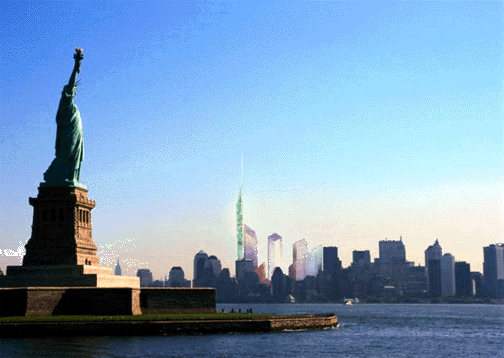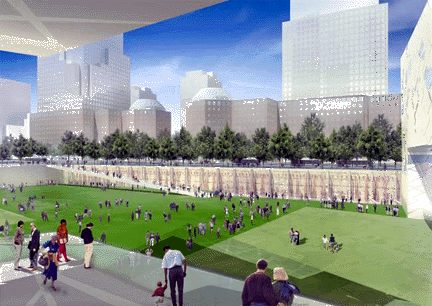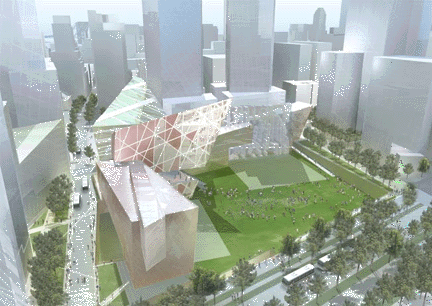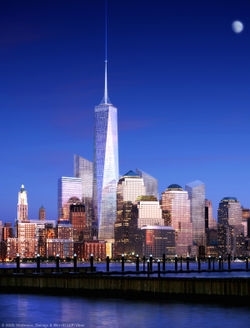 |
| from September 11th News.com: What the new New York skyline will look like once Libeskind's design comes to fruition. |
Daniel Libsekind's architectural designs are endless juxtapositions. They honor the historical yet are unapologetically modern. Some view his work, such as the spiral addition to the Victoria and Albert Museum in London, as controversial - while others view it as a brilliant representation of modern-day architecture in all its glory. His work harmoniously combines materials, shapes, and structure in a way most thought impossible, improbable, and many would even say, questionable.
But what critics do agree upon is his design for New York City's new Twin Towers. The design has been called the "architecture of the spirit and emotions" in its use of space and lack, thereof. Ever mindful of the tragedy that occured on September 11th, 2001 and the victims which perished at the site, the design was viewed as the perfect balance between the city's need to move forward and rebuild and its residents' need to remember, honor, and mourn. Libeskind himself called the design both "a place of mourning" and "forward-looking, optimistic."
 |
| from September 11th News.com: Libeskind's plan (computer-generated) |
The design leaves the footprints, the foundations, of the Twin Towers open and untouched. Libeskind "uses the exposed 30-year-old bathtub wall memorial 70-foot-deep hole memorial site at the Ground Zero which consists of an elevated walkway to encircle the hole with new buildings around its perimeter, and a landmark tower spire that reaches 1,776 feet." He has reportedly changed the original design which called for a memorial at 70-feet below ground, to 30 feet, to allow for infrastructure and transportation underneath.
Libeskind's towers represent the spirit, tenacity, and renewal of New York City in the face of tragedy and terrorism. The main tower will both surpass the height of the original trade center, which at 1,350 feet were briefly the world's tallest, and Malaysia's Petronas Twin Towers which currently stand at 1,483 feet as the tallest buildings in the world. Of the 9 proposals submitted, Libeskind's design is said to have been favored by New York's Governor George Pataki and NYC Mayor Michael Bloomberg, perhaps because of the defiance and spirit of courageousness it boldly represents.
 |
| from September 11th News.com: Libeskind's plan (computer-generated) |
Libeskind, himself, is a product of courage and determination in the face of striking violence. He was born in Poland in 1946 to Holocaust survivors and their own strength and spirit of survival was evidently instilled in his blood. Not surprisingly, he is best known for designing Berlin's acclaimed Jewish Museum. He came to the United States at the age of 13 on a boat with his parents, his first view of the country being the Statue of Liberty - an image that forever left an imprint in his mind. He became a U.S. citizen in 1965 and his brilliant mind for architecture would eventually lead him to be considered amongst the foremost architects of the world.
Not a stranger to accolades, Libeskind was the first architect ever to have received the Hiroshima Art Prize which honors artists who promote peace through their work. It is then not surprising why this promoter of peace, this forerunner of innovation and progression, would be chosen to rebuild America's beloved World Trade Center.
 |
| One World Trade Center: Freedom Tower |
Due to various factors, including funding strain, some differences in the overall vision of what the site should ultimately become, and pressure from various dueling entities on all levels, real estate investor Larry Silverstein ultimately handed over some of the rights to the Freedom Tower building to the Port Authority in April of 2006. Likewise, the design of the Freedom Tower was given to a new set of architects at SOM (Skidmore, Owings and Merrill).
Nevertheless, Daniel Libeskind remains in control of the grand plan for the rebuilding of Ground Zero, which includes much more than the widely-discussed Freedom Tower. From the 9/11 memorial, to 7 stories of underground infrastructure which includes underground transportation, an ocean of offices (10 million square feet, to be exact), a new park, and even new city streets, Libeskind still holds one of the greatest roles in the redesign and rebuild of what may be the world's most talked about construction project, or as Libeskind refers to it: "the rebirth of lower Manhattan."
He feels that too much emphasis has been placed on the Freedom Tower, particularly by the foreign press, and that likewise, the vastness of the project has been shadowed by the controversy and conflicting interests and opinions regarding one portion of the reconstruction. Although he admits that releasing control of the Freedom Tower to another architect has been difficult for him, the magnitude of the whole project and the overall vision he holds for the site, has kept him incredibly busy and pleased, nevertheless.
Although things have changed somewhat in recent years, Libeskind is still a key player in the rebuilding of the World Trade Center site and will forever hold a place in history as one of the greatest architects the world has ever known.
Page created on 2/28/2015 6:26:46 PM
Last edited 2/28/2015 6:26:46 PM

Click here to listen to the Daniel Libeskind story.